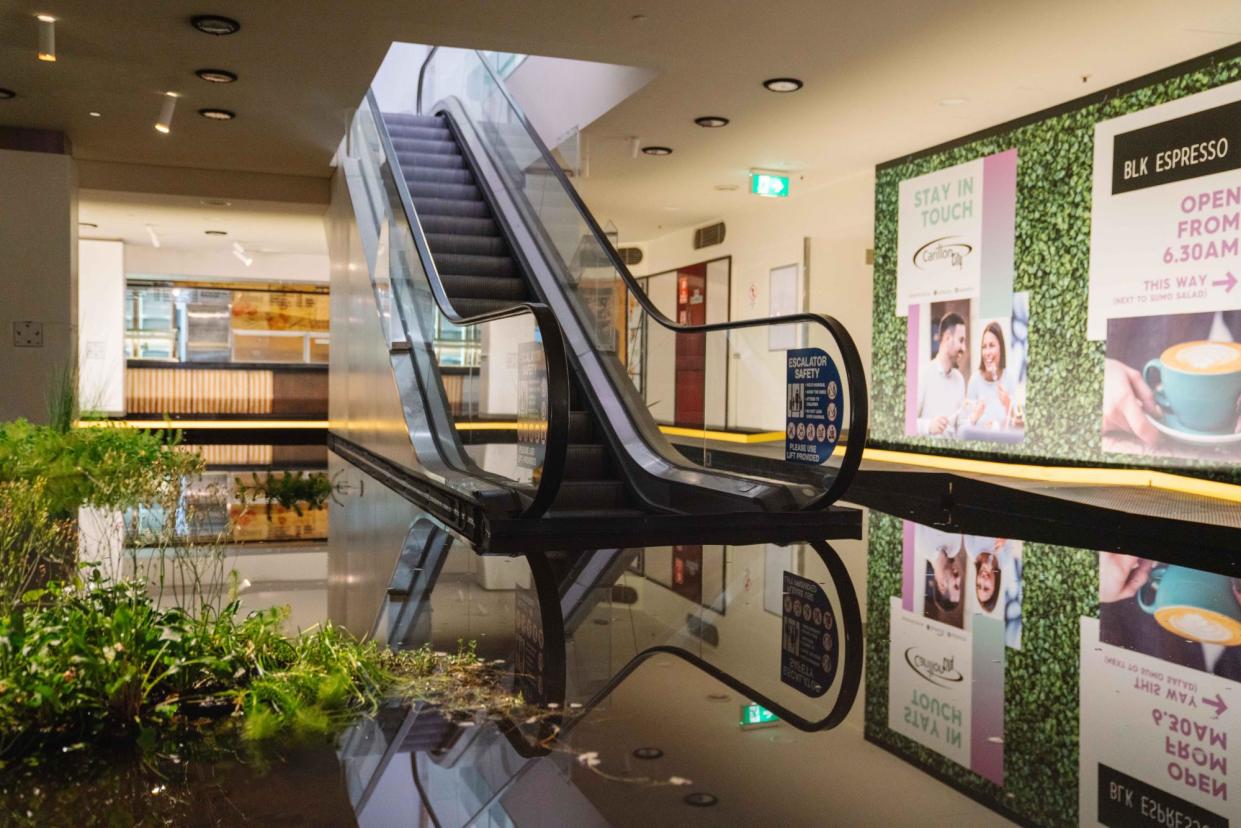‘Nature will have her way’: how a desolate Perth shopping mall has been transformed into a sprawling wetland

As a fresh-faced 16-year-old in mid-2000s Perth, one of my favourite pastimes was to spend the day at Carillon City. I’d catch the 34 bus into town and loiter around its labyrinth of shops — circling its elaborate golden balustrades, trying on clothes and eating sushi on the shiny tables of its 80s-style food court.
Visiting the desolate, shopper-less mall more than 20 years later, I feel a surge of conflicting emotions. The food court, once teeming with people eating and chatting under glowing neon signs, is not only eerily quiet but flooded with an inky black pool of water, as if a viral outbreak has removed all life from the place.
“For many people who grew up in Perth, Carillon City is incredibly nostalgic,” says Annika Kristensen, visual arts curator at Perth festival, whose major commission Wetland by Linda Tegg has transformed the vacant basement into a swampy marshland. “This is very unexpected. I’ve seen people gasp when they walk down the escalator.”
Earmarked for a multimillion-dollar redevelopment by Andrew Forrest’s property division Fiveight, Carillon City has lain dormant since 2021. But the ground where the mall stands was once a food court of a very different kind: a sprawling brackish wetland and a source of nourishment for Noongar people.
Responding to the 2024 Perth festival theme of Ngaangk (the Noongar word for sun), in Wetland the Melbourne-based Tegg expands on her practice of assembling plant life within the built environment. She collaborated with a Balladong Whadjuk woman and medicinal plant expert, Vivienne Hansen, to peel back the layers of the site’s history and identify the plant life that would have grown here pre-colonisation.
As if sprouting up from beneath the floor to reclaim its rightful place, the wetland is speckled with happily growing Noongar bush foods including kondil (sheoak) and taaruk (old man’s beard).
“Wetland is this living thing – it brings people together with plants,” Tegg says. “I like to think about how we might be able to live differently amongst other lifeforms. And how we might be able to find spaces for them in our own patterns of living.”
Walking on the illuminated boardwalk that loops around the space, I’m greeted by a maze of idle signage – the shiny red counter of Sarpino’s pizzeria; the gold lettering of the Chinese Canton cafe – some of which was left behind by vendors, and some recreated by Tegg.
It’s a potent contrast, seeing these decaying retail relics alongside the quiet marvel of the native plants – both, in a sense, buried under our cities by urbanisation and development. In Perth, where deforestation has had devastating impacts on endemic wildlife, Wetland feels particularly poignant.
“They’re going to demolish that building,” Hansen says. “It seems fitting that the exhibition is there, because a lot of the [urban] progress that’s been made has been destroying our wetlands and our native food sources.”
Hansen describes Perth’s lost wetlands as a “supermarket” for Noongar people, who would have foraged for plants such as mardja (bloodroot), whose red-coloured bulbous roots were a food staple; and bibool (saltwater paperbark), which was used to make a sweet tea called mangite or mungite.
Sitting alongside Wetland is Rebecca Baumann’s Light Event, a kaleidoscopic light installation in Carillon City’s glass atrium, where dichroic film casts an ever-changing palette of colour across the soaring, cylindrical space.
I experience a particular pang of sadness looking up at a mural depicting sunbathers at Cottesloe beach in the 1930s, glowing under Rebecca’s orange and magenta light, and realising it might be the last time I see it.
As we exit the installation, I see a trail of office workers on their lunch breaks behind us, catching their last glimpses of this urban relic.
“This was such a busy centre for commerce,” Kristensen says. “Now it’s dormant and what will replace it we still don’t know. But we have this moment where it’s kind of in between states.”
“[We’ve] really suppressed nature but I see these two works as a representation that she will have her way. The sun will find its way in, and the water will find its way to rise.”
Wetland and Light Event are free to the public until 3 March as part of Perth festival


